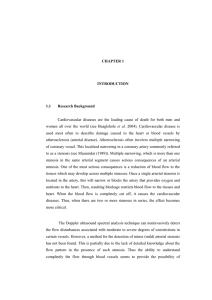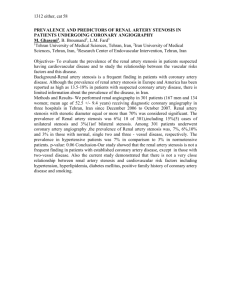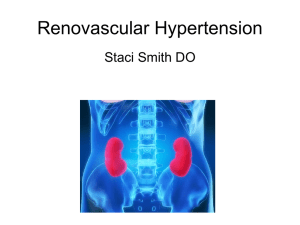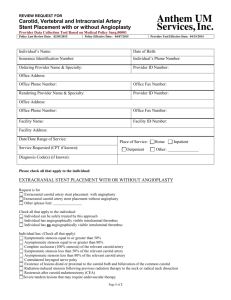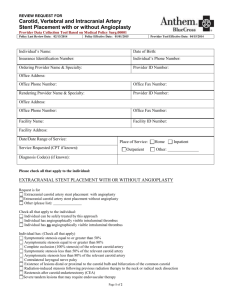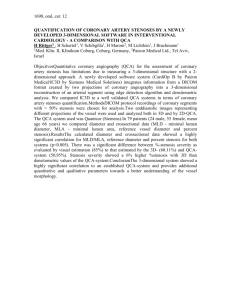CHAPTER I INTRODUCTION 1.1 Introduction
advertisement
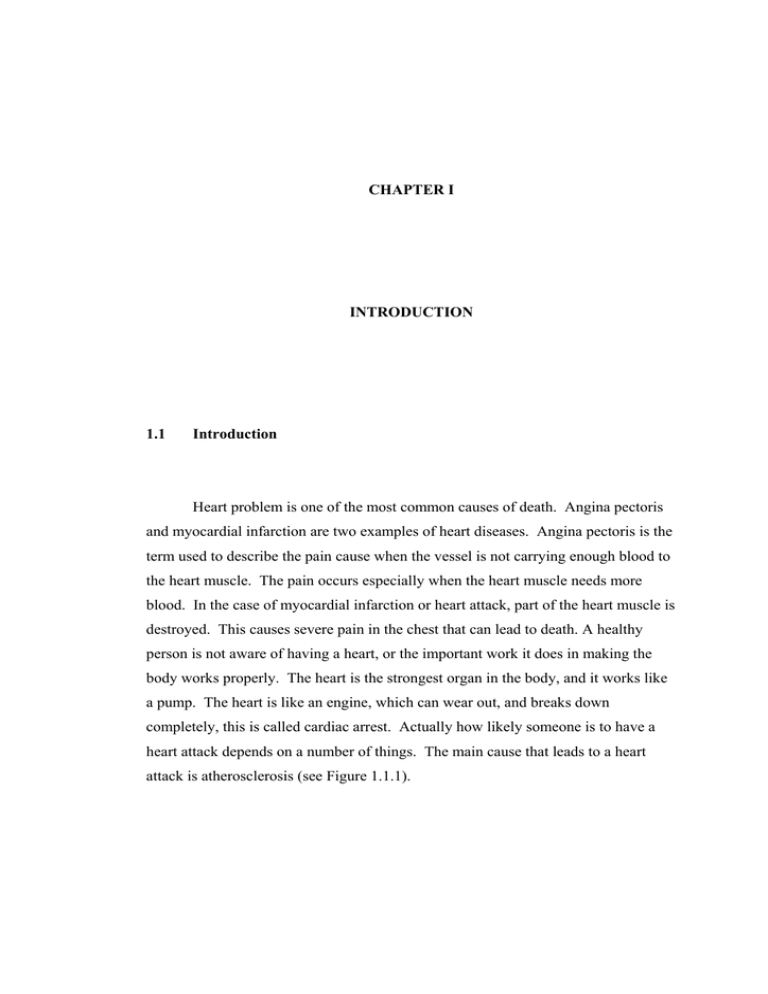
CHAPTER I INTRODUCTION 1.1 Introduction Heart problem is one of the most common causes of death. Angina pectoris and myocardial infarction are two examples of heart diseases. Angina pectoris is the term used to describe the pain cause when the vessel is not carrying enough blood to the heart muscle. The pain occurs especially when the heart muscle needs more blood. In the case of myocardial infarction or heart attack, part of the heart muscle is destroyed. This causes severe pain in the chest that can lead to death. A healthy person is not aware of having a heart, or the important work it does in making the body works properly. The heart is the strongest organ in the body, and it works like a pump. The heart is like an engine, which can wear out, and breaks down completely, this is called cardiac arrest. Actually how likely someone is to have a heart attack depends on a number of things. The main cause that leads to a heart attack is atherosclerosis (see Figure 1.1.1). 2 Figure 1.1.1 Atherosclerosis Chakravarty (1987) mentioned that atherosclerosis occurs when the nature of blood flow changes from its usual state to a disturbed flow condition due to the presence of a stenosis in an artery. Stenosis is defined as a partial occlusion of the vessels caused by abnormal growth of tissues or the deposition of cholesterol as substances on the arterial wall. This research considers the study of blood flow through arteries in the presence of stenosis because it can cause the development of cardiovascular diseases such as stroke and heart attack (see Figure 1.1.2). Figure 1.1.2 Stenosis that Exists in Coronary Artery Restricts Blood Flow to the Heart. The fact that blood exhibits non – Newtonian behaviour was actually first recognised around the turn of the century (Enderle et al. (2000)). From a biofluid mechanics point of view, blood would not be expected to obey the very simple, one parameter, and linearized law of viscosity as developed by Newton. Blood is 3 nonhomongeneous, anisotropic ionic, composite fluid composed of a suspension of many asymmetric, relatively large, viscoelastic particles carried in a liquid that contains high molecular weight, asymmetric, ionic that behaves in a complicated way under shear – type loading. Therefore, blood exhibits non-Newtonian (nonlinear), time dependent (viscoelastic) deformation (flow) characteristics that can only be modelled by higher order constitutive equations, such as the power-law paradigm (Enderle et al. (2000)). In physiological flows, there are other important factors that can be accounted for such as the effects of vessel tapering together with the geometry of stenosis. It has been pointed out that most of the vessels could be considered as long and narrow, slowly tapering cones. Besides, the process of systolic and diastolic also affects the vessels segment because it makes the vessel segment converges and diverges. Thus the effects of vessel tapering together with the non-Newtonian behaviour of the streaming blood seem to be equally important, hence deserves special attention. In the next sections, we present the research background for the project followed by the objectives, scope, significance of research and outline of the dissertation. 1.2 Research Background A number of researchers have studied the flow of non-Newtonian fluids with various perspectives. Ronald L. Fournier (1998) explained about the field of rheology concerns the deformation and flow behaviour of fluids, the prefix rheo is from Greek and refers to something that flows because of the particulate nature of blood. He expected the rheological behaviour of blood to be some what more complex than a simple fluid such as water. He mentioned that in order to understand the flow behaviour of blood, one must first define the relationship between shear stress and the shear rate. Ishikawa et al. (1998) found that the non-Newtonian 4 pulsatile flow through a stenosed tube is different from Newtonian flow. The nonNewtonian property strengthens the peaks of wall shear stress and wall pressure, weakens the strength of the vortex and reduces the vortex size and separated region. Therefore, he concluded that non-Newtonian flow is more stable than Newtonian flow. Chakravarty and Mandal (1994) studied the unsteady flow behaviour of blood in an artery under stenotic condition analytically, by considering blood to be a nonNewtonian fluid and by properly accounting for blood viscoelasticity while the geometry of the stenosis was chosen to be overlapping to some extent, depending on time. Chakravarty et al. (1996) investigated the effect of a single cycle of body acceleration on unsteady non-Newtonian blood flow past a time-dependent arterial stenosis. Mandal (2005) pointed out that in some disease conditions, for example, patients with severe myocardial infarction, cerebrovascular diseases and hypertension, blood exhibits non-Newtonian properties. Gijsen et al. (1999) studied the impact of non-Newtonian properties of blood on the velocity distribution. They made a comparison between the non-Newtonian fluid model and a Newtonian fluid at different Reynolds numbers. Comparison reveals that the character of flow of the non-Newtonian fluid is simulated quite well by using the appropriate Reynolds number. Cheng Tu and Michel Deville (1995) noticed that for non-Newtonian flow through 75% stenosis, the influence of the geometrical disturbance affects the flow over a longer axial range. John Enderle et al. (2000) pointed out those significant attempts to define such non-Newtonian behaviour, however did not appear until the 1960s, when variable-shear rotational viscometers were introduced. Since then, literally dozens of constitutive models have been proposed that attempt to relate shear stress to shear rate in the fluid. They said, the most practical of these is an empirical power law formulation that generalizes Newton’s law of viscosity. R. Manica and A.L. de Bortoli (2003) presented the simulation of incompressible non-Newtonian flow through channels with sudden expansion using the Power Law model. The Power Law model is applied to predict pseudoplastic (shear thinning) and dilatant (shear thickening) behaviour in such expansions. They pointed out that a better understanding of non-Newtonian flow through sudden expansions should lead to 5 both the design and development of hydrodynamically more efficient process and to an improved quality control of the final products. The effect of vessel tapering is another important factor that should be considered. Chakravarty and Mandal (2000) formulated the problem on tapered blood vessel segment having overlapping stenosis. The problem is modelled mathematically as a thin elastic tube with a circular section containing an incompressible Newtonian fluid representing blood. Jeffords and Knisley (1956) and Bloch (1962) pointed out that most of the vessels could be considered as long and narrow, slowly tapering cones (Chakravarty and Mandal (2000)). Inside a normal artery, red and white blood cells and other particles can flow freely to the peripheral organs. The walls of the inner linings of arteries are smooth and uniform in thickness. As an initial study, Formaggia et al. (2003) and Lee and Xu (2002) observed blood flow behaviour in non-stenotic vessel or a normal artery. Over time, however, the stenosis can build up within the artery walls. Quite a good number of theoretical studies related to blood flow through stenosed arteries have been carried out recently, Misra and Chakravarty (1989), Chakravarty (1987) and Chakravarty and Datta (1987). Most of the studies carried out so far have been focused on the presence of mild or single stenosis as discussed by Chakravarty et al. (1995, 1996, 2000), Chakravarty and Mandal (1997, 2000), Taylor et al. (1998), Lee and Xu (2002) and Mandal (2005). Moayeri and Zendehboodi (2003) found that once a mild stenosis is developed, the resulting flow disorder plays an important role in the further development of the disease. In order to update resemblance to the in vivo situation, some studies have been investigated an overlapping stenosis in blood vessel segment subject to the pulsatile pressure gradient. Chakravarty and Mandal (1996), noted that the problem becomes more acute in the presence of an overlapping stenosis in the artery instead of having a mild stenosis as considered by aforesaid researchers. The study has been extended by Chakravarty and Mandal (2000) to include the time-dependent geometry of an overlapping stenosis present in a tapered artery. However, these studies considered a Newtonian model for blood flow. Beside the mild and overlapping 6 stenosis, Chakravarty and Sannigrahi (1999) gave special attention to multistenoses which appear in the artery. There are different methods of solution in solving the problem of blood flow in normal and stenosed artery. Some researchers are solving analytically and some of them use numerical methods. Gerrald and Taylor (1977) used the finite difference method to solve the problem of blood flow in a normal artery. The finite difference method based on the central difference approximation has been employed by Chakravarty and Mandal (1994, 1997) and Mandal (2005). Misra and Pal (1999) observed the blood motion using Crank Nicolson implicit finite difference method. Runge-Kutta formula has been used by Chakravarty and Mandal (1996, 2000), Chakravarty et al. (1995, 1996, 2000) and Chakravarty and Sannigrahi (1999). Beside the finite difference scheme, the finite element method has also been employed. Sud and Sekhon (1986) used the finite element model of flow in the normal branched arterial system subject to externally imposed periodic body acceleration and the relevance works have been extended by Sud and Sekhon (1987) by considering a stenosed artery. Formaggia et. al. (2003) presented a finite element Taylor-Galerkin scheme combined with operator splitting techniques in order to carry out several test cases. 1.3 Objectives of Research The main objective of this research is to develop a mathematical model for non-Newtonian blood flow through a tapered stenotic artery. The specific objectives are: 1. To derive the governing equations of blood flow, comprising the equation of continuity and the equation of motion in terms of the viscous shear stress. 7 2. To formulate the geometry of mild stenosis. 3. To carry out the radial coordinate transformation on the governing equations. 4. To solve the governing equations numerically using a finite difference scheme. 1.4 Scope of Research This research takes into consideration the stenotic blood flow through the tapered artery to be incompressible, unsteady, two-dimensional and axisymmetric under laminar flow condition. The flowing blood is treated as a non-Newtonian fluid that is characterized by the generalized Power-law model and is observed through a mild stenosis. The discussion of this problem follows from the work of (Mandal (2005)). 1.5 Significance of Study The benefits of this study are: 1. The development of a more realistic mathematical model to describe blood flow. 2. The development of a numerical package for the computation and simulation of bio-fluid problems. 8 1.6 Outline of Dissertation This dissertation is divided into six chapters including this introductory chapter. Section 1.2 – 1.5 present the research background, objectives, scope and significance of research. Chapter II presents the derivation of the governing equations. First, we show the derivation of continuity equation and then the derivation of the equation of motion in terms of the viscous stress tensor, τ . After that, both equations will be converted to cylindrical coordinates. The derivations of these formulae are given in Appendix A. Then, we show the derivation of the mathematical model. The last section in this chapter states the boundary conditions. The next chapter contains a discussion on the geometry of stenosis with their mathematical formulation. Then, we will show how to formulate the geometry of mild stenosis in a non-tapered and tapered artery. The following chapter presents the transformation of the governing equations using the radial coordinate transformation. Then, the derivations of the radial velocity component, vr ( x, z , t ) and the solution of the axial velocity component, vz ( x, z , t ) are shown using the finite difference method. In the same section, the volumetric flow rate, the resistance and the wall shear stress will be determined. Next, we will show the numerical procedure to programme the finite difference method using MATLAB programming. The complete program is given in Appendix B. Lastly, in this chapter we state some comments about the numerical results. Chapter V discusses the numerical results. This chapter will be divided into eight sections including the introduction. In Section 5.2, we discuss the results for the axial and radial velocities at different taper angles under stenotic conditions and also at taper angle with comparison between flow through stenosis, non stenosis and steeper stenosis. Next section, the results and discussion for axial and radial velocity at different times and at different type of fluid in the same times are given. Section 9 5.4 will be presented the results for axial and radial velocity at different axial positions. The following section will illustrate the results of the variation flow rate, resistance and wall shear stress with time. Last sections we will state some comments about the results obtained. Finally, Chapter VI will conclude the research problem and list out several suggestions for future research.

